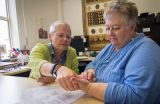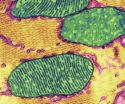(Press-News.org) Depending on habitat availability, the endangered Indiana bat may be able to use its social connections to survive a certain amount of roost destruction, according to research by scientists at Virginia Tech and The Ohio State University.
Alexander Silvis of Lynchburg, Ohio, and Andrew Kniowski of Boones Mill, Virginia, both doctoral students in Virginia Tech's College of Natural Resources and Environment, made findings from Ohio State field studies highly visual by applying graphic and spatial approaches to the data.
"Social dynamics are important to bat roosting behavior," said Silvis, who is studying fish and wildlife conservation. "And now, looking at results of a study of roosting and foraging activity in a new light, we have evidence that Indiana bats make social contacts during foraging."
"An improved understanding of Indiana bat social structure and roosting behavior could greatly benefit efforts to minimize impacts of human land use on the species and provide insight into habitat management efforts," said W. Mark Ford, an associate professor of Virginia Tech's Department of Fish and Wildlife Conservation, who leads the Virginia Cooperative Fish and Wildlife Research Unit and advises both Silvis and Kniowski.
Silvis, Kniowski, and Ford, along with Stanley D. Gehrt, an associate professor and wildlife extension specialist at The Ohio State University, co-authored an article on their research that appeared in May in PLOS ONE.
Indiana bats form maternity colonies in summer beneath the bark of live trees or standing dead trees known as snags. The Ohio State researchers conducted their study in Pickaway County, Ohio, which is dominated by cropland with only 9 percent woodland.
They captured and radio-tagged bats from maternity colonies in 2009 and 2010, tracked their activity to determine foraging areas and roosts, and counted bats as they exited roosts. They captured 23 Indiana bats in 2009, of which 14 were adult females and the rest juveniles. They captured 26 bats in 2010, 20 of which were adult females.
Tracking the radio-tagged bats to roosts, they observed that the female bats didn't always return to the same roost. Applying their new approach to the data, "We were able to map a network of connections between the roosts," said Kniowski, who is in the interdisciplinary geospatial and environmental analysis program at Virginia Tech and works out of the Department of Fish and Wildlife Conservation.
A comparison of the 2009 and 2010 network maps revealed a dispersed roost area in 2009 and a dense network in 2010, with only the most central roosts reused in the second year. The roost area for the entire colony was more than 6.5 square miles in 2009 and less than a square mile in 2010, whereas the foraging area was about 14 square miles both years.
Some flexibility is to be expected in terms of roosting, given the transitory nature of snags, the researchers note in the article. "Roost conditions are very fleeting," said Silvis, who also did his master's research at Ohio State under Gehrt.
But the substantial dispersion of the roosts in 2009 could have been dangerous for the bats. The researchers simulated the removal of roosts to determine the robustness of the colony. Removal of only 5 percent of roosts in 2009 would have resulted in fragmentation of the network, whereas it would have required removal of half of the roosts to fragment the tightly knit network of 2010.
The researchers suggested in the article that they may have witnessed colony behavior changes associated with roost deterioration. In 2009, the colony may have been scattered, seeking a suitable primary roost, following abandonment of a primary roost the previous year. Then in 2010, the colony concentrated roosting activity in the proximity of the new, most suitable roost.
"There is evidence that the colony was using a different primary roost two years prior to our study," they wrote. "In areas with greater amounts of forest or roosting resources, bats may not need to disperse as far in search of new roosts allowing a more stable roosting area."
"We happened to catch the bats at a time when a tree probably became 'ideal,'" said Kniowski.
"Indiana bats do not select the most stable environment for their roosts," said Silvis, "which makes it all the more critical that we understand their social dynamics and how to manage the conditions of their habitats."
The team also observed greater foraging area overlap than expected, "which does not necessarily equate to association, and further may be an artifact of the location of the highest quality foraging habitat," they cautiously noted. "However, a high level of overlap should be positively related to the potential for association."
They optimistically suggest, that in cases of roost loss, "foraging area overlap supports the idea that social connections could be re-established during foraging bouts."
"The study highlights a level of complexity in both roost and roosting area use that has not been previously described and raises questions about the resiliency of Indiana bats to roost loss," said Ford.
"Identifying the similarities and differences in colony structure across an array of geographic locations and habitat configurations would provide insight into the biological and ecological factors influencing colony behavior," Ford continued. "However, reductions in population size due to white-nose syndrome, a disease that has significantly impacted the Indiana bat and other bat species, probably preclude such opportunities, making the social dynamics revealed by Kniowski, Silvis, and Gehrt all the more profound."
INFORMATION:
Bats make social alliances that affect roosting behavior
Researchers tap social networks of endangered Indiana bat to help manage habitat
2014-06-17
ELSE PRESS RELEASES FROM THIS DATE:
Researchers map genomic differences in yellow fever, malaria mosquitoes
2014-06-17
Virginia Tech entomologists have developed a chromosome map for about half of the genome of the mosquito Aedes agypti, the major carrier of dengue fever and yellow fever.
With the map, researchers can compare the chromosome organization and evolution between this mosquito and the major carrier of malaria, the Anopheles gambiae mosquito, to find ways to prevent diseases.
"Despite looking somewhat similar, these mosquitoes diverged from each other about 150 million years ago. So, they are genetically further apart than humans and elephants," said Maria Sharakhova, a ...
Study reveals livestock gut microbes contributing to greenhouse gas emissions
2014-06-17
"Increased to levels unprecedented" is how the Intergovernmental Panel on Climate Change (IPCC) described the rise of carbon dioxide, methane and nitrous oxide emissions in their report on the physical science basis of climate change in 2013. According to the US Environmental Protection Agency (EPA), the atmospheric concentration of methane, a greenhouse gas some 28 times more potent than carbon dioxide has been steadily growing since the 18th century and has now increased by 50 percent compared to pre-industrial levels, exceeding 1,800 parts per billion.
The EPA attributes ...
'Vital signs' of teaching captured by quick, reliable in-class evaluation
2014-06-17
A 20-minute classroom assessment that is less subjective than traditional in-class evaluations by principals can reliably measure classroom instruction and predict student standardized test scores, a team of researchers researchers reported.
The assessment also provides immediate and meaningful feedback making it an important new tool for understanding and improving instructional quality, according to psychologists from the University of Rochester and the University of North Carolina at Chapel Hill.
"Education researchers broadly agree that teachers matter," explained ...
EHRA White Book 2014 highlights growing use of complex therapies for heart rhythm abnormalities
2014-06-17
Nice, France, 17 June 2014. The EHRA (European Heart Rhythm Association) White Book 2014 will be officially launched at the CARDIOSTIM EHRA EUROPACE 2014 congress which starts today in Nice, France.
The White Book reports on the current status of arrhythmia treatment in 49 of the 56 European Society of Cardiology (ESC) member countries for the year 2013. The new White Book is published in electronic format only and will be distributed on a USB stick as well as being available on the EHRA website. As a new feature, the USB stick contains complete data also from the six ...
Distracted minds still see blurred lines
2014-06-17
VIDEO:
Participants were asked to look at an image with moving sections blurred, while performing a cognitive 'n-back' task.
Click here for more information.
Montreal, June 17, 2014 — From animated ads on Main Street to downtown intersections packed with pedestrians, the eyes of urban drivers have much to see. But while city streets have become increasingly crowded with distractions, our ability to process visual information has remained unchanged for millions of years. ...
Pain pilot explores hand shiatsu treatment as sleep aid
2014-06-17
(Edmonton) There was a time, back in Nancy Cheyne's youth, when she combined the poise and grace of a ballerina with the daring and grit of a barrel racer. When she wasn't pursuing either of those pastimes, she bred sheepdogs, often spending hours on her feet grooming her furry friends at dog shows.
All that seems like a lifetime ago. After 15 years of living with chronic lower-back pain, Cheyne, 64, can't walk from the disabled parking stall to the elevator at work without stopping for a rest. She eats mostly junk food because it hurts too much to stand over the stove ...
Single dose reverses autism-like symptoms in mice
2014-06-17
In a further test of a novel theory that suggests autism is the consequence of abnormal cell communication, researchers at the University of California, San Diego School of Medicine report that an almost century-old drug approved for treating sleeping sickness also restores normal cellular signaling in a mouse model of autism, reversing symptoms of the neurological disorder in animals that were the human biological age equivalent of 30 years old.
The findings, published in the June 17, 2014 online issue of Translational Psychiatry, follow up on similar research published ...
Breast cancer diagnosis, mammography improved by considering patient risk: INFORMS paper
2014-06-17
A new approach to examining mammograms that takes into account a woman's health risk profile would reduce the number of cancer instances missed and also cut the number of false positives, according to a paper being presented at a conference of the Institute for Operations Research and the Management Sciences (INFORMS).
Mehmet U.S. Ayvaci of the University of Texas Dallas will present his research group's findings about the role of risk profiling in the interpretation of mammograms at Advances in Decision Analysis, a conference sponsored by the INFORMS Decision Analysis ...
Boost for dopamine packaging protects brain in Parkinson's model
2014-06-17
Researchers from Emory's Rollins School of Public Health discovered that an increase in the protein that helps store dopamine, a critical brain chemical, led to enhanced dopamine neurotransmission and protection from a Parkinson's disease-related neurotoxin in mice.
Dopamine and related neurotransmitters are stored in small storage packages called vesicles by the vesicular monoamine transporter (VMAT2). When released from these packages dopamine can help regulate movement, pleasure, and emotional response. Low dopamine levels are associated with neurodegenerative diseases ...
Gut bacteria predict survival after stem cell transplant, study shows
2014-06-17
(WASHINGTON, June 17, 2014) – New research, published online today in Blood, the Journal of the American Society of Hematology, suggests that the diversity of bacteria in the gastrointestinal tract of patients receiving stem cell transplants may be an important predictor of their post-transplant survival.
A healthy gastrointestinal tract contains a balanced community of microorganisms (known as microbiota), largely comprised of "friendly" bacteria that aid digestion and are important to immune system function. When this community of microbes is compromised, the microbiota ...
LAST 30 PRESS RELEASES:
Sports injuries sustained during your period might be more severe
World's first successful 2 Tbit/s free-space optical communication using small optical terminals mountable on satellites and HAPS
Can intimate relationships affect your heart? New study says ‘yes’
Scalable and healable gradient textiles for multi‑scenario radiative cooling via bicomponent blow spinning
Research shows informed traders never let a good climate crisis go to waste
Intelligent XGBoost framework enhances asphalt pavement skid resistance assessment
Dual-function biomaterials for postoperative osteosarcoma: Tumor suppression and bone regeneration
New framework reveals where transport emissions concentrate in Singapore
NTP-enhanced lattice oxygen activation in Ce-Co catalysts for low-temperature soot combustion
Synergistic interface engineering in Cu-Zn-Ce catalysts for efficient CO2 hydrogenation to methanol
COVID-19 leaves a lasting mark on the human brain
Scientists use ultrasound to soften and treat cancer tumors without damaging healthy tissue
Community swimming program for Black youth boosts skills, sense of belonging, study finds
Specific depressive symptoms in midlife linked to increased dementia risk
An ‘illuminating’ design sheds light on cholesterol
Who is more likely to get long COVID?
Study showcases resilience and rapid growth of “living rocks”
Naval Research Lab diver earns Office of Naval Research 2025 Sailor of the Year
New Mayo-led study establishes practical definition for rapidly progressive dementia
Fossil fuel industry’s “climate false solutions” reinforce its power and aggravate environmental injustice
Researchers reveal bias in a widely used measure of algorithm performance
Alcohol causes cancer. A study from IOCB Prague confirms damage to DNA and shows how cells defend against it
Hidden viruses in wastewater treatment may shape public health risks, study finds
Unlock the power of nature: how biomass can transform climate mitigation
Biochar reshapes hidden soil microbes that capture carbon dioxide in farmland
Reducing saturated fat intake shows mortality benefit, but only in high-risk individuals
Manta rays create mobile ecosystems, study finds
Study: Mixed results in using lipoic acid to treat progressive multiple sclerosis
Norbert Holtkamp appointed director of Fermi National Accelerator Laboratory
New agentic AI platform accelerates advanced optics design
[Press-News.org] Bats make social alliances that affect roosting behaviorResearchers tap social networks of endangered Indiana bat to help manage habitat



